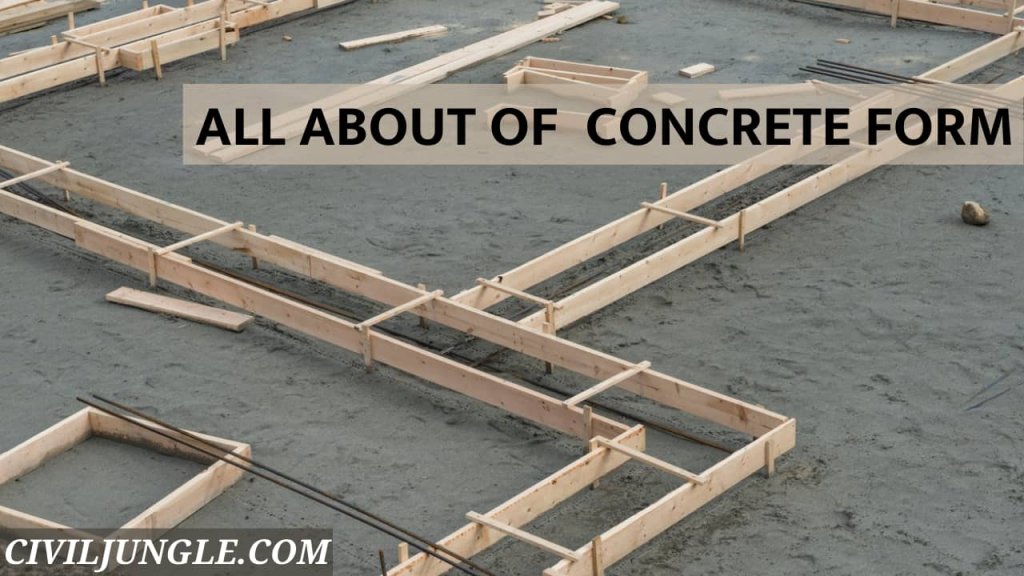
What Is Concrete Form?
A concrete form is a system of formwork for reinforced cement concrete which is made with rigid thermal insulation. The concrete formwork is necessary to provide a shape of that concrete.
Types of Concrete Forms, Uses, Advantage, Disadvantages and Thai applications.
Types of Concrete Forms
For the concrete casting there are many types of concrete forms are used, that’s are below-
1. Wooden Form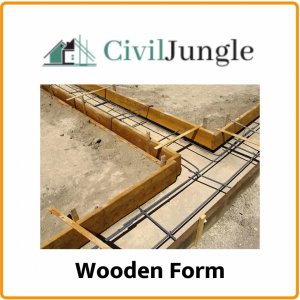
The wooden form is the most conventional and basic type of concrete form, for casting concrete it is mainly used. The height of the wooden forms should not be exceeding 6 inches.
The wooden form consists of some wooden boards that are tight between either screwed or nailed to get a desired formwork or mold shape. For the correct level or slope special leveling equipment are used as per requirements.
When we need for laying concrete from any type of free-form design or any curves, then to make the form thin cross-section is employed.
Before pouring the concrete, we ensure that the inside surface of the concrete form should be applied with any form of releasing agent or low-grade oil, so that the concrete does not attach to the boards.
If we properly maintained and cleaned the boards, then it can be used much time for work.
Uses of Wooden Concrete Form
The uses of wooden form are below-
- The uses of wooden form is, when we need for laying concrete from any type of free-form design or any curves, then to make the form thin cross-section is employed.
- The wooden form is the most conventional and basic type of concrete form, for casting concrete it is mainly used.
Advantage of Wooden Concrete Forms
Advantages of wooden concrete forms are below-
- The advantage of wooden concrete forms is, to make any shape of the residential building the wooden concrete forms are used.
- Another advantage of wooden concrete forms is, the wooden form is the most conventional and basic type of concrete form, for casting concrete.
Disadvantage of Wooden Concrete Forms
Disadvantages of wooden concrete forms are below
- The disadvantage of the wooden concrete form is, for the heavy concrete structure, the wooden concrete forms cannot be used.
- A wooden concrete form is most costly.
Application of Wooden Concrete Forms
The applications of wooden form are below-
- The wooden forms can be applied, when we need for laying concrete from any type of free-form design or any curves, then to make the form thin cross-section is employed.
- It may be applying for any residential building construction and industrial construction.
2. Insulated Concrete Form
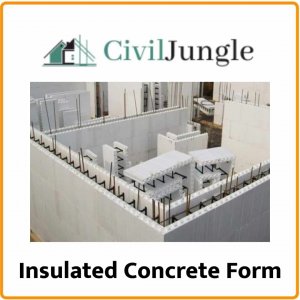
Insulated concrete form manufactured as a hollow block and used as an insulating material used for constructing building blocks.
On the foundation slab these techniques are constructed and the reinforcement is placed inside these blocks and filled with the required cast or slump concrete.
To get the excessive energy efficiency, the concrete and forms are laid like sandwiches. By pouring with the concrete in the boards, it is not necessary to remove the board at first as possible.
Uses of Insulated Concrete Forms
- The insulated concrete forms use as insulating materials used for constructing building blocks.
- To get the excessive energy efficiency, the concrete and forms are used like sandwiches.
- The insulated concrete forms can be used as a building designer material.
Advantage of Insulated Concrete Forms
- It can be used for construct building blocks.
- By this we can obtain desired design on the residential building.
Disadvantage of Insulated Concrete Forms
The disadvantage of insulated concrete forms is below
- The disadvantage of insulated concrete forms is, because of it is a hollow block, for this the strength of this concrete blocks is less from the other concrete forms.
- For installation of this types of forms expert workers are needed.
Applications of Insulated Concrete Forms
- The insulated concrete forms can be applied, to make a building block.
- And it also can be applying, for the design of building walls and floors.
3. Foam Concrete Form

The foam concrete form follows non-traditional methods so the specified finish is obtained that the concrete is poured upside down. This types of forms are manufactured from acrylic glass, melamine, or laminated boards.
By that foam concrete forms, we obtained a creative look, create adverse spaces to the ultimate concrete cast.
Uses of Foam Concrete Form
- The foam concrete form can be used for; the specified finish is obtained and the concrete is poured upside down.
- Another uses of this is, by that foam concrete forms, we obtained creative look, create adverse spaces to the ultimate concrete cast.
Advantage of Foam Concrete Form
The advantages are below of foam concrete form-
- The advantage of foam concrete form is, by this we can obtain a creative look, create adverse spaces to the ultimate concrete cast.
- By this we can decorate the building as our requirement.
Disadvantage of Foam Concrete Form
Some disadvantage of foam concrete form is given below-
- The uses of foam concrete form are costlier in the construction and needed more time for the construction. This is a common disadvantage of this.
- For this expert’s workers are needed.
Applications of Foam Concrete Form
The applications of foam concrete form are given below-
- The applications of foam concrete form are, we obtained creative look, create adverse spaces to the ultimate concrete cast.
- We can be applying for; the specified finish is obtained and the concrete is poured upside down.
4. Concrete Wall Forms
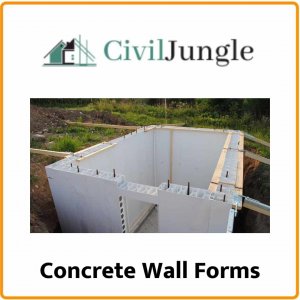
The concrete wall forms techniques we used to make of large space walls, piers, and foundations. The concrete wall forms are some pre-fabricated formation techniques.
The concrete wall forms techniques are generally made with steel framing from either engineering wooden or solely steel and individual elements are joined together by latches or pins.
In this technique to carry the reinforcement ties are used. When the wall forms are available in numerous shapes and sizes. For the custom shape, there are have additional producers that’s should be followed as a requirement.
Uses of Concrete Wall Forms
The uses of concrete wall forms are given below-
- The concrete wall forms techniques we used to make of large space walls, piers, and foundations.
- When the wall forms are available in numerous shapes and sizes, in this technique to carry the reinforcement ties is used.
Advantages of Concrete Wall Forms
There have been many advantages of concrete wall forms that are below-
- The common advantage of concrete wall forms is, it can be used to make of large space walls, piers, and foundations.
- Another advantage of concrete wall form is; it can be easily usable.
Disadvantages of Concrete Wall Forms
There have been many disadvantages of concrete wall forms that are below-
- The disadvantage of concrete wall forms is, it is not used for small works like small residential building, etc.
- Another disadvantage of concrete wall forms are its increase the construction cost of the structure.
Applications of Concrete Wall Forms Is
There have been many applications of concrete wall forms that are below-
- We can apply the concrete wall forms, to make large space walls, piers, and foundations.
- For decorating desired shape and size of the structure of a building, we can be applying the concrete wall forms.
5. Steel Concrete Forms
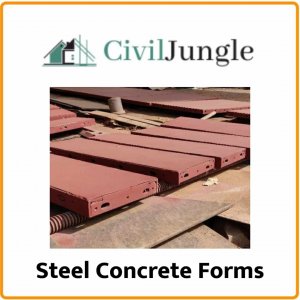
The steel concrete forms are generally manufactured by steel, even 2000 work cycles the stability of steel forms may be achieved, if properly the form used and maintained.
From the wooden concrete forms, it is most durable and more costly. For decreasing the errors in the concrete forms, steel-concrete forms are used, because of the steel forms do not absorb moisture from the concrete.
Uses of Steel-Concrete Forms
- This form opts-in large-area walls, foundations, piers, etc.
- This is generally made with engineering wood with steel framing.
Advantages of Steel-Concrete Forms
- The main advantage of steel concrete form is its robust, sturdy, and longer lifespan.
- Assembled and removing process is very fast compared to others.
Disadvantages of Steel-Concrete Forms
- It is not economical because the cost is higher.
- The weight of these are too much so it requires lifting equipment.
- Corrosion will easily occur in this.
- Shape and size are limited in this.
Application of Steel-Concrete Forms
- This is generally made with engineering wood with steel framing.
- This form opts in large-area walls, foundations, piers, etc.
Free Form Concrete
Here are some details about free form concrete:
- Off-form concrete is a construction material that’s created by pumping concrete through a nozzle to form it into a predetermined shape
- Sprayed concrete is an ideal material for constructing freeform structures because it can form curved shapes
- Wood has been the concrete contractor’s formwork of choice for years because it’s relatively inexpensive, lightweight, and easy to understand and replace
- Plastic concrete forms can be used to create slants or curves, and can work around landscaping obstructions
Concrete forms are solid barriers that help to hold the fluid concrete in place until it hardens and acquires a particular shape.
FAQ
What Is a Concrete Form?
A concrete form is a temporary or permanent structure used to mold and support concrete while it sets and cures. It helps shape the concrete into the desired form and ensures it stays in place until it hardens.
What Are the Different Types of Concrete Forms?
The main types of concrete forms include:
- Wooden Forms: Traditional and versatile, used for various shapes and designs.
- Insulated Concrete Forms (ICFs): Hollow blocks used for insulation and constructing walls.
- Foam Concrete Forms: Made from materials like acrylic glass or laminated boards for creative and intricate designs.
- Concrete Wall Forms: Prefabricated forms used for large walls, piers, and foundations.
- Steel Concrete Forms: Durable and used for large-scale construction, made from steel framing.
What Are the Advantages of Using Wooden Concrete Forms?
Wooden forms are cost-effective, versatile, and easy to handle. They are ideal for creating complex shapes and are reusable if properly maintained.
What Are the Disadvantages of Wooden Concrete Forms?
Wooden forms may not be suitable for heavy structures, can be expensive over time, and may deteriorate with repeated use.
How Do Insulated Concrete Forms (Icfs) Benefit a Construction Project?
ICFs provide excellent insulation, reducing energy costs and improving energy efficiency. They also simplify the construction process by combining formwork and insulation in one product.
What Are the Drawbacks of Insulated Concrete Forms?
ICFs can be less strong compared to other forms and may require specialized knowledge for proper installation. They can also be more expensive than traditional forms.
When Should Foam Concrete Forms Be Used?
Foam concrete forms are used for creating unique and artistic designs, including complex curves and shapes. They are ideal for applications where aesthetic considerations are important.
What Are the Advantages and Disadvantages of Foam Concrete Forms?
Advantages include the ability to create intricate and creative designs. Disadvantages include higher costs and the need for skilled labor for proper installation.
What Are Concrete Wall Forms and Their Primary Uses?
Concrete wall forms are used to construct large walls, piers, and foundations. They are prefabricated and can be made from steel or wood, with various shapes and sizes available.
What Are the Benefits and Limitations of Steel Concrete Forms?
Steel concrete forms are highly durable, reusable, and have a long lifespan. They can be more expensive and heavier than other types of forms, which may require additional equipment for handling.
What Is Free Form Concrete and How Is It Applied?
Free form concrete involves using techniques like spraying or pumping to create unconventional and artistic shapes. It is suitable for projects that require unique and curved structures.
How Do Concrete Forms Impact the Overall Construction Process?
Concrete forms are essential for shaping and supporting concrete, ensuring that the final structure has the correct dimensions and strength. They also impact the speed and cost of the construction process.

